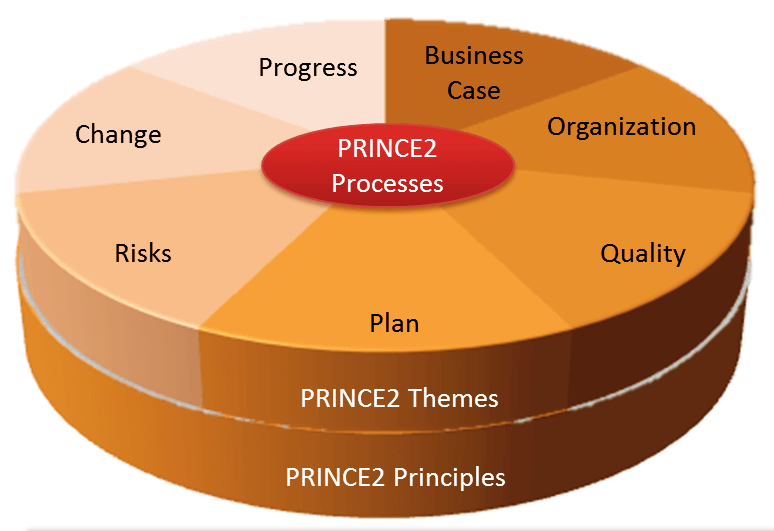PRINCE2 project management is a structured approach that offers numerous benefits for organisations looking to effectively manage and implement projects. This article aims to provide a comprehensive understanding of the benefits of PRINCE2, its key principles, themes, and processes, as well as the advantages it brings. Furthermore, it will delve into a comparison of PRINCE2 with other project management methodologies and discuss how to successfully implement PRINCE2 within an organisation.
The benefits of PRINCE2 for project management
Implementing PRINCE2 project management methodology can yield a wide range of benefits for organisations:
👉 Improved project organisation and planning
PRINCE2 provides a clear structure for project organisation, ensuring that roles and responsibilities are defined and understood. This enables better communication and coordination, leading to more efficient planning and execution of projects.
Furthermore, with PRINCE2, project managers have access to a comprehensive set of templates and tools that aid in project planning. These resources facilitate the creation of detailed project plans, including timelines, milestones, and resource allocation. By having a well-organised project plan, teams can easily track progress, identify potential bottlenecks, and make necessary adjustments to keep the project on track.
👉 Enhanced risk management
PRINCE2 emphasises proactive risk management, with regular assessments and strategies in place to mitigate potential issues. This approach minimises the impact of risks and increases the likelihood of project success.
In addition to regular risk assessments, PRINCE2 encourages the identification of risks at the earliest stages of a project. This allows project teams to develop contingency plans and allocate resources accordingly. By addressing risks proactively, organisations can avoid costly delays and disruptions, ensuring that projects stay on schedule and within budget.
👉 Increased project success rates
By adhering to the PRINCE2 methodology, projects are better controlled and monitored, avoiding common pitfalls and ensuring they are delivered on time, within budget, and to the required quality standards. Consequently, the overall success rates of projects are significantly improved.
Moreover, PRINCE2 promotes regular project reviews and lessons learned sessions. These activities provide valuable insights into project performance and allow organisations to identify areas for improvement. By continuously refining project management practices, organisations can enhance their project success rates over time, leading to increased customer satisfaction and improved business outcomes.
Understanding PRINCE2 project management
PRINCE2, which stands for Projects IN Controlled Environments, is a widely used project management methodology that originated in the United Kingdom. It provides a standardised approach to managing projects, ensuring they are delivered efficiently and with consistent quality.
PRINCE2 is based on a set of seven principles that serve as the foundation for effective project management. These principles are not just theoretical concepts but have been proven to work in practice. Let's delve deeper into each of these principles to gain a better understanding of how they contribute to project success.
The 7 principles of PRINCE2
1. Continued business justification: This principle emphasises the importance of regularly reviewing and validating the business case for the project. It ensures that the project remains aligned with the organisation's objectives and provides ongoing value.
2. Learning from experience: PRINCE2 encourages project teams to learn from both their successes and failures. By capturing lessons learned and applying them to future projects, organisations can continuously improve their project management practices.
3. Defined roles and responsibilities: Clear roles and responsibilities are crucial for effective project management. PRINCE2 defines specific roles, such as the project manager, team manager, and project board, ensuring that everyone understands their responsibilities and can work together efficiently.
4. Managing by stages: PRINCE2 breaks down projects into manageable stages, with each stage having its own objectives, deliverables, and review points. This approach allows for better control and decision-making throughout the project lifecycle.
5. Managing by exception: PRINCE2 promotes a management approach where decisions are made at the appropriate level of authority. By setting tolerances and empowering project managers to make day-to-day decisions, senior management can focus on strategic issues and intervene only when necessary.
6. Focusing on products: PRINCE2 emphasises the importance of defining and delivering tangible products or outcomes. This product-focused approach ensures that the project delivers the desired results and provides a clear basis for planning and control.
6. Focusing on products: PRINCE2 emphasises the importance of defining and delivering tangible products or outcomes. This product-focused approach ensures that the project delivers the desired results and provides a clear basis for planning and control.
7. Tailoring to suit project environments: PRINCE2 is not a one-size-fits-all methodology. It recognises that projects come in different sizes, complexities, and contexts. Therefore, it provides a flexible framework that can be tailored to suit the specific needs and characteristics of each project.
By adhering to these principles, project teams can establish a solid foundation for successful project delivery and achieve desired outcomes.
The 7 themes of PRINCE2
In addition to the principles, PRINCE2 incorporates seven themes that are essential aspects to be addressed throughout the project lifecycle. These themes provide guidance on key areas that need to be considered and managed to ensure project success.
1. Business case: The business case theme ensures that there is a justifiable reason for undertaking the project and that it remains viable throughout its lifecycle. It involves regularly reviewing and updating the business case to ensure continued alignment with organisational objectives and benefits.
2. Organisation: The organisation theme focuses on defining clear roles, responsibilities, and reporting lines within the project. It ensures that the project team structure is appropriate and that there is effective communication and coordination among team members.
3. Quality: The quality theme emphasises the importance of delivering products and outcomes that meet defined quality criteria. It involves establishing quality management processes, conducting regular quality reviews, and ensuring that quality standards are maintained throughout the project.
4. Plans: The plans theme involves creating and maintaining a robust project plan that outlines the approach, activities, and resources required to deliver the project. It includes developing various levels of plans, such as the project plan, stage plans, and team plans, to ensure effective planning and control.
5. Risk: The risk theme focuses on identifying, assessing, and managing risks throughout the project. It involves conducting risk assessments, developing risk response strategies, and regularly monitoring and reviewing risks to minimise their impact on project objectives.
6. Change: The change theme addresses the need for effective change management within the project. It involves identifying and assessing potential changes, evaluating their impact, and implementing appropriate change control procedures to ensure that changes are properly authorised and managed.
7. Progress: The progress theme is concerned with monitoring and controlling the project's progress against the plan. It involves regular reporting, tracking of key performance indicators, and taking corrective actions to address any deviations from the plan.
By addressing these themes throughout the project lifecycle, organisations can ensure that key aspects are properly managed, reducing the likelihood of issues and increasing the chances of project success.
The 7 processes of PRINCE2
PRINCE2 defines seven processes that provide a step-by-step guide for project management. These processes ensure that projects are properly planned, executed, and controlled, leading to successful outcomes.
1. Starting up a project: This process involves the pre-project activities required to ensure that the project is viable and can be successfully initiated. It includes activities such as defining the project's objectives, identifying stakeholders, and creating the project brief.
2. Initiating a project: The initiation process involves developing a detailed project plan, including defining the project's scope, objectives, deliverables, and governance structure. It also involves securing the necessary resources and obtaining approval to proceed with the project.
3. Directing a project: The directing process is primarily the responsibility of the project board, who provide overall direction and decision-making authority. They review progress, approve stage plans, and ensure that the project remains aligned with organisational objectives.
4. Controlling a stage: This process focuses on the day-to-day management of each project stage. It involves monitoring progress, managing risks and issues, and ensuring that the stage remains on track. Regular stage assessments are conducted to assess progress and make informed decisions.
5. Managing product delivery: This process is concerned with the creation and delivery of the project's products or outcomes. It involves coordinating the work of the project team, ensuring that products meet quality standards, and obtaining necessary approvals before delivering them.
6. Managing stage boundaries: The stage boundary process occurs at the end of each project stage. It involves reviewing the completed stage, updating plans, and obtaining approval to proceed to the next stage. It also provides an opportunity to reassess the project's viability and make any necessary adjustments.
7. Closing a project: The closing process involves formally closing the project once its objectives have been achieved or when it is no longer viable. It includes activities such as conducting project reviews, documenting lessons learned, and transitioning project deliverables to operational teams.
By following these processes, project teams can ensure that projects are well-managed, risks are mitigated, and objectives are achieved.
How PRINCE2 compares to other project management methodologies
While PRINCE2 is a widely recognised project management methodology, it is valuable to understand how it compares to other methodologies in the field.
Agile project management focuses on adaptability and flexibility, allowing teams to respond to changing requirements quickly. In contrast, PRINCE2 provides a more structured and controlled approach. The decision of using PRINCE2 or Agile will depend on the nature and specific requirements of the project.
Agile methodologies have gained popularity in recent years due to their ability to deliver projects in a fast-paced and dynamic environment. The Agile approach emphasises collaboration, continuous improvement, and customer satisfaction. It encourages teams to work in short iterations, delivering incremental value to stakeholders.
On the other hand, PRINCE2 offers a comprehensive framework that covers all aspects of project management, including planning, control, and governance. It provides a clear structure and defined roles and responsibilities, ensuring that projects are managed in a controlled and efficient manner. PRINCE2 is particularly suitable for large and complex projects where a high level of control and documentation is required.
PRINCE2 versus Waterfall
Waterfall project management follows a linear process, progressing from one phase to another. PRINCE2, on the other hand, allows for iterative and adaptive project management, providing better control and risk management capabilities compared to the waterfall approach.
The waterfall methodology is a traditional approach that involves completing each phase of a project before moving on to the next. This sequential process provides a clear structure and allows for detailed planning upfront. However, it can be inflexible when it comes to accommodating changes or addressing unforeseen issues during the project lifecycle.
PRINCE2, with its focus on flexibility and adaptability, allows project managers to make adjustments as needed throughout the project. It emphasises regular reviews and continuous improvement, ensuring that projects remain on track and aligned with business objectives. By incorporating feedback and lessons learned, PRINCE2 enables teams to respond effectively to changes and mitigate risks.
PRINCE2 versus Scrum
Scrum is a specific Agile framework focused on iterative development and self-organising teams. PRINCE2, while compatible with Scrum, offers a broader project management framework that encompasses principles, themes, and processes beyond the development cycle.
Scrum is widely used in software development projects, where requirements are likely to change frequently. It promotes collaboration, transparency, and adaptability through its iterative approach. Scrum teams work in short sprints, delivering working increments of the product at regular intervals.
PRINCE2, on the other hand, provides a holistic approach to project management that can be applied to various industries and sectors. It covers not only the development phase but also the initiation, planning, execution, and closure stages of a project. PRINCE2 incorporates principles such as managing by exception, focusing on business justification, and tailoring the methodology to suit the project's needs.
While Scrum focuses primarily on the development cycle, PRINCE2 provides a broader perspective and addresses the overall management of a project. It ensures that projects are delivered within the agreed scope, time, and budget, while also considering the business case and stakeholder requirements.
Implementing PRINCE2 in your organisation
Introducing PRINCE2 into an organisation requires careful planning and coordination. Here are key considerations for successful implementation:
Training and certification for PRINCE2
To ensure the successful utilisation of PRINCE2, training programs and PRINCE2 Foundation and Practitioner certifications should be provided to project managers and stakeholders. This helps to build a common understanding and language around project management practices, enabling effective adoption.
Integrating PRINCE2 with existing processes
Integrating PRINCE2 with existing processes and methodologies is crucial for seamless implementation. By aligning PRINCE2 with the organisation's existing structures, organisations can leverage the benefits of PRINCE2 while maintaining continuity.
Overcoming common challenges in PRINCE2 implementation
Implementing PRINCE2 may present certain challenges, such as resistance to change or lack of buy-in. To overcome these challenges, organisations should focus on creating a culture that embraces PRINCE2, providing sufficient training and support, and communicating the benefits of the methodology to all stakeholders.
In conclusion, PRINCE2 project management offers a structured and comprehensive approach to managing projects. By understanding the principles, themes, and processes of PRINCE2, organisations can enjoy improved project organisation, enhanced risk management, and increased project success rates. Comparing PRINCE2 to other methodologies helps organisations choose the most suitable approach for their project's requirements. Successful implementation of PRINCE2 involves investing in training and certification, integrating PRINCE2 with existing processes, and addressing common implementation challenges. By embracing PRINCE2, organisations can effectively manage projects, deliver successful outcomes, and drive overall project excellence.



